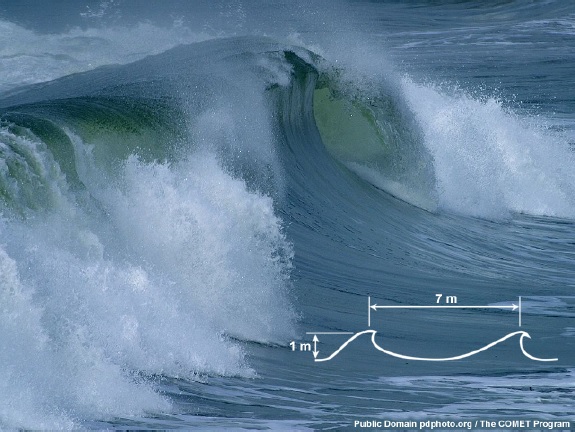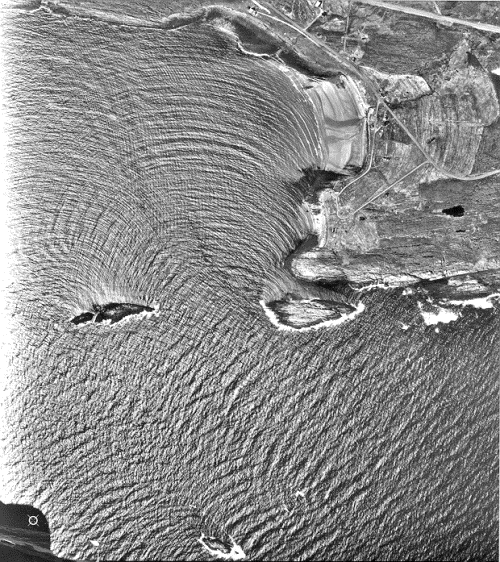ATSC 113 Weather for Sailing, Flying & Snow Sports
Breaking Waves
Learning Goal 8c: Explain how wave and beach-slope characteristics determine the types of breaking waves.
Waves are formed out in the open ocean and can travel vast distances before breaking on a distant coastline. The energy carried by these waves and the way they break against the shoreline has dramatic impacts on erosion and how shorelines are shaped over time.
As waves approach the shore, the bottom of the wave meets the ocean floor. As they drag across the bottom, the front waves slow down, and wavelength is reduced. The following waves start to build up behind the slow ones, and as the wavelengths get shorter, the wave energy gets transferred upwards, increasing wave height. The friction along the bottom slows the base of the wave down while the water at the surface continues forward. When the wave steepness (the ratio between wave height and wavelength) exceeds a ratio of 1:7, it becomes unstable and breaks. The slope of the sea floor greatly influences how quickly the sea floor affects the waves as the waves get closer to shore, and therefore how the waves break.

Source: UBC EOSC 114
Local tides and the direction in which the ocean swell approaches the shore can also influence the way in which waves break. If ocean swell approaches the shore at an angle, which it typically does, waves reaching the shallow water first will break first. The break will then progress parallel to the shoreline as the rest of the wave gradually reaches shallower water. We will touch on this again in Learning Goal 8d on Anticipating Swell.

Hopefully, you will never be sailing through breaking waves, as it would cause significant damage to your boat and likely injure those on board (see video below). However they are an important hazard to consider when sailing in coastal areas where breakers can also form over reefs or sand bars.
There are three basic types of breaking waves: spilling breakers, plunging breakers, and surging breakers.
Spilling Breakers
Spilling breakers occur as waves travel across a gently sloping bottom (i.e., gently sloping sea floor near the beach). The wave breaks long and slow, losing its energy as white water spilling from the crest down the front of the wave.

Source: Mendax - Own work (Original text: selbst erstellt), CC BY-SA 2.0 de, https://commons.wikimedia.org/w/index.php?curid=40273068
Plunging Breakers
Plunging breakers occur as waves approach moderate to steep bottoms. The wave becomes steeper than a spilling breaker and the crest falls as a well-defined curl, falling forward with considerable energy. The tube that forms as these waves hit the shore at an angle and progress across the shoreline is what surfers love.

Source: Mendax - selbst erstellt auf der Grundlage photographischer Aufnahmen im Wellenkanal, CC BY-SA 2.0 de, https://commons.wikimedia.org/w/index.php?curid=40273009
Surging Breakers
Surging breakers occur when long wave period, low amplitude waves approach moderately steep shores. The wave doesn’t spill or curl; it builds up and then slides rapidly up the beach with less foam or spray than the other two breakers.

Source: Mendax - Own work (Original text: selbst erstellt), CC BY-SA 2.0 de, https://commons.wikimedia.org/w/index.php?curid=40273146
Extra Info for Everyone & Additional Resources: (non-required material)
Water Encyclopedia – Waves: http://www.waterencyclopedia.com/Tw-Z/Waves.html
Videos: (non-required material)
Sailboat takes on plunging breakers (not smart, do not try this!): https://www.youtube.com/watch?v=ml5wBgV7iMs
Mavericks – big waves with plunging breakers in California (surfing videos):
Keywords: wavelength, wave height, wave steepness, swell, spilling breaker, plunging breaker, surging breaker, wave period, amplitude
Image credits: Government sources for the tables above are indicated in or near the table captions, and in the Extra Info box.